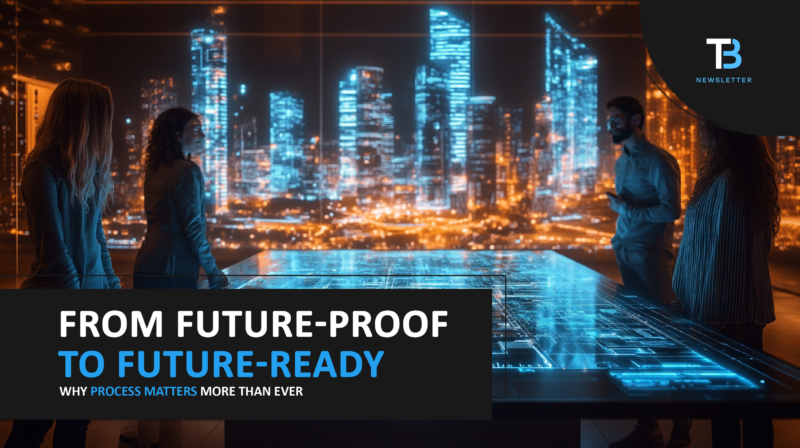
How a design-first, people-focused approach creates adaptable buildings built for what’s next
📅 Published by Layer 10 | Thought Leadership in Smart Building Strategy
Why “Future-Proofing” Is The Wrong Strategy
In the fast-evolving world of commercial real estate and smart buildings, the term “future-proof” is everywhere. But at Layer 10, we believe it’s time for an upgrade—not in the tech, but in the mindset.
“Future-proofing” implies resistance. A defensive stance. A way to protect buildings from inevitable technological obsolescence. But in our experience, the future doesn’t reward resistance—it rewards readiness.
Instead of trying to build structures that outlast change, we help our clients embrace change as a driver of innovation and opportunity. That means designing with adaptability, deploying with flexibility, and planning for a lifecycle of evolution—not just installation.
Future-Ready Means Process-Driven
Being future-ready isn’t about predicting which technology will dominate in five years. It’s about building the strategic infrastructure—both technical and organizational—to evolve as needs change.
And that starts with process.
At Layer 10, we champion a design-first, user-centered, and product-agnostic methodology. This framework allows us to guide clients through technology integration in a way that’s agile, collaborative, and scalable.
Here’s what that looks like in action:
1️⃣ Design-First Thinking
Smart buildings aren’t defined by the hardware you install—they’re shaped by the decisions you make in early-stage design.
Too many projects wait until construction is underway—or worse, complete—before thinking seriously about technology. By that point, your best options are already off the table.
A future-ready process begins at the start:
- What are the goals of the space?
- How should technology support operations, experience, and performance?
- What infrastructure is needed to enable flexibility later?
By anchoring technology in the design process, you eliminate rework, reduce risk, and position your building to evolve.
2️⃣ User-Centered Integration
Great technology is invisible. It enables experiences without interrupting them. But far too often, smart buildings are built around feature sets—not around people.
We take a different approach. At Layer 10, every decision is filtered through the lens of:
- Who will use this space?
- What are their habits, workflows, and expectations?
- How can we remove friction and increase intuitive control?
This people-first process ensures that what gets built actually gets used—and that your investment translates into measurable value for end users.
3️⃣ Product-Agnostic Strategy
In a future-ready framework, flexibility is non-negotiable. That’s why Layer 10 remains fully product-agnostic.
We don’t push proprietary ecosystems or lock clients into vendor relationships. Instead, we evaluate solutions based on:
- Functionality
- Compatibility
- Scalability
- Cost-effectiveness
This approach helps our clients avoid vendor lock-in, reduce future upgrade costs, and stay open to next-generation techwithout disrupting what’s already in place.
Collaboration is What Makes It All Work
Process doesn’t happen in a silo—and neither does future-readiness. The smartest buildings are built through collaboration, not consultation.
That’s why we work side by side with:
🔹 Developers
🔹 Architects
🔹 Contractors
🔹 Operators
🔹 Large employers and end users
From early visioning sessions to post-deployment optimization, we co-design the strategy together. Our clients aren’t passive recipients of technology—they’re active partners in shaping how it functions, adapts, and delivers value.
This collaboration leads to stronger alignment, clearer expectations, and better results—every time.
Deployment Is Not the End—It’s the Middle
Most technology consultants treat deployment as the finish line. We see it as just another stage in a long-term journey.
Here’s how our process continues:
✅ Strategic Design – Defining requirements, aligning with vision, and building future flexibility
✅ Deployment Oversight – Guiding integrators, coordinating teams, and ensuring alignment with the plan
✅ Post-Launch Optimization – Adapting systems to user behavior, upgrading when needed, and improving ROI over time
This lifecycle approach makes our clients resilient—not just in the face of technology change, but in market shifts, tenant turnover, and operational evolution.
Why Process > Product in the Long Run
The best technology in the world can fail in a building that isn’t designed for it. But a thoughtfully designed process will always yield outcomes that are:
- More integrated
- More adaptable
- More people-centric
- More valuable
At Layer 10, future-readiness isn’t something we install. It’s something we build—with you, for you, and alongside you.
🎓 Learn the Process Behind Future-Ready Projects
At Layer 10 Academy, we teach the methods, strategies, and leadership mindset required to bring technology into the built environment with purpose and impact.
If you’re ready to:
✅ Lead tech conversations early
✅ Avoid costly rework
✅ Build systems that adapt with time
…then you’re ready to go from future-proofing to future-readiness.
🔗 Explore the Academy at https://layer10.com/academy-home/
Final Thoughts: Shaping What’s Next, Together
We believe technology should elevate how people experience the built world—not complicate it.
And we believe that future-ready buildings are designed by teams who plan with intent, lead with empathy, and execute with flexibility.
That’s how we build smarter spaces. That’s how we create enduring value.
Let’s build tomorrow, today.
📌 Related Resources: